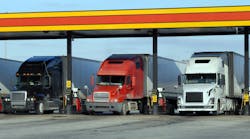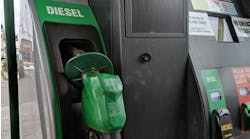Performance-based driver incentives help fleet save $2M in fuel costs
DALLAS—It’s highly unlikely diesel prices will get back to normal levels anytime soon. Even under normal circumstances, fuel remains a consistent top operational expense for fleets.
Regardless of the current economic climate and persistently high fuel costs, Artur Express, an asset-based, full-service truckload carrier serving the continental U.S., has saved nearly $2 million in just fuel costs over the past year.
The carrier, through driver buy-in and training, has implemented a performance-based points program that tracks certain driver behaviors and habits that directly impact fuel economy. Drivers earn points—the more the better—that are tied to how much more money they are paid by mile. The highest earners typically run 8,000 miles a month with a fuel average of 8 mpg or better for the company’s drop-and-hook operations. They also have at least 90% on-time deliveries, 100% completion of pre- and post-trip inspections, and maintain zero violations.
See also: Diesel average dips, but more price hikes may be brewing amid shortage concerns
When the carrier decided to implement the program back in 2019, the company's fuel average was 6.9 mpg. Now, three years into the program and with a recently developed fleet relations team, the fleet is averaging 7.7 mpg and has managed to save $2 million in the last 12 months, Kristi Randall, VP of operations for Artur Express, explained during Women In Trucking’s 2022 Accelerate Conference & Expo.
“That’s money that we can then give back to the drivers,” she said.
Through the program, fleet managers focus on driver habits that impact mpg, such as braking and acceleration, cruise control, speed, idling, and following distance. Depending on how many points they earn, drivers are ranked in platinum, gold, silver, and bronze status levels.
“We’ve found that over the past year, we saved 4 cents per mile with our platinum drivers, so that is about $20,000 worth of savings per truck per year,” Randall said, adding that 44 company drivers currently hold that platinum status.
If all of Artur Express’ 350 drivers reached platinum levels, that would be a cost savings of about $4,152,037 per year, she added.
Fuel-saving tactics put in place
It’s controversial, but one way Artur Express has saved on fuel is by governing truck speeds.
“Even though drivers definitely don’t like it, we have found that taking speeds down from 70 to 68 mph is a huge savings, and then taking them down from 68 to 65 mph is another huge savings in fuel,” Randall said.
That, Randall explained, takes having a good dispatcher that can plan ahead with drivers. After earning more for saving fuel, some of the company’s drivers have even chosen to reduce their speeds to 62 mph and 58 mph on cruise control. Those drivers have been averaging 9 mpg, Randall pointed out.
See also: ATA, OOIDA weigh in on FMCSA's plan to mandate speed limiters
“Another thing that a lot of people don’t think about is cruise control,” she added. “Cruise control creates a fuel economy of 6% and it helps reduce driver fatigue.”
Idle time, on the other hand, kills fuel economy, so the carrier has based 30% of driver scores on idle reduction. To address the problem, the carrier has added APUs across its entire fleet.
“Work with your drivers to ask them why they are idling and figure out if there is way that you can stop the idling or at least reduce it,” Randall said. “It’s all about the way you communicate with the drivers to understand what they need and also get them to accept the changes that will impact their fuel economy.”
In addition to working with tenured drivers, Artur Express also initiated a training program to teach new drivers how to drive efficiently right off the bat.
Aside from paying drivers who save fuel more per mile, the carrier also created a quarterly contest in which the company selects platinum-status drivers to receive between $500 and $1,000 bonuses. After the first quarter of 2023, the company is conducting what will be an annual $20,000 gift giveaway where drivers can choose whether they want a fishing boat, motorcycle, car, or similar large-ticket item valued at $20,000.
“We’re spending less than $50,000 a year to motivate these drivers with these gifts, but we are saving a lot,” Randall noted. “About $2 million of that goes back into driver pay. It’s all about motivating your drivers and how you can give back to them.”
The maintenance, vehicle lifecycle equation
Artur Express’ fleet relations group understands that having drivers work hand in glove with the maintenance team to monitor things like tire pressure, addressing warning lights, and sticking to preventive maintenance cycles is crucial for both fuel efficiency and overall cost savings.
Further, keeping vehicles properly maintained has become increasingly important as the industry continues to experience a shortage of new production slots, a shortage of used trucks because demand is so high, and parts shortages, Al Barner, Fleet Advantage’s SVP of strategic fleet solutions, told FleetOwner during WIT’s conference.
“It has forced a lot of companies to extend their lifecycles well beyond what they normally would want,” Barner explained. “We have to really focus on getting back to the basics and making sure you have a good preventive maintenance program, making sure you’re monitoring fuel costs closely because of the expense of fuel now, and that all comes with making sure you’re properly maintaining aftertreatment systems.”
Barner also pointed out that another way for fleets to experience better fuel economy is by reducing equipment trade cycles. By pulling data from trucks’ onboard computers and shop management systems, Fleet Advantage contends that a vehicle trade cycle between 400,000 and 500,000 miles is more cost effective in the long run.




